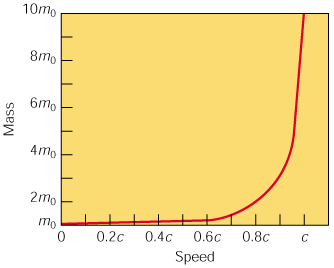 . The result of this equation is
that as you approach the speed of light, the mass becomes infinitely heavy.
. The result of this equation is
that as you approach the speed of light, the mass becomes infinitely heavy.
Special Relativity: Einstein’s special theory was based on two postulates
1) The physical laws are the same in all inertial frames of reference.
2) The speed of light in a vacuum is constant for all observers, regardless of the motion of the source or the observer.
This second law contradicts what we are used to observing.
If you and another car are moving toward each other and you are both
going 50 miles an hour, from your frame of reference, the car coming at you is
moving at 100 mph. On the other
hand if you are both going down Beach Blvd in the same direction, from your
frame of reference, the other car is standing still.
What Einstein said was that no matter how fast you are moving, light always moves at the same speed relative to you (3x108 m/s). The result of this is that the speed of light becomes the upper limit to speed.
If that is true, what would happen to a rocket as it approached the speed of
light. We are still applying a
force, what happens to counteract this force.
The answer is that the mass increases.
The equation for mass is
 . The result of this equation is
that as you approach the speed of light, the mass becomes infinitely heavy.
. The result of this equation is
that as you approach the speed of light, the mass becomes infinitely heavy.

FIG. 3-19
The relativity of mass. The greater the speed of an object relative to an
observer, the greater the object's mass appears to the observer. This effect is
conspicuous only at speeds near the speed of light c, which is 3 x 108
m/s, about 186,000 mi/s.